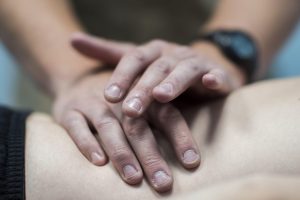Post-Exercise Massage

Massage is commonly administered to reduce muscle stiffness and enhance recovery from exercise. However, the effect that massage has on muscle stiffness following exercise has not been researched. A study from Singapore published in Journal of Sport Science & Medicine examined the effect of post-exercise massage on passive muscle stiffness over a five-day period.
Study
The trial was a randomized cross-over study involving 18 male recreational runners. The runners conducted a 40-minute downhill running exercise on a treadmill.
For each participant, one randomly selected leg received a 16-minute standardized massage routine targeting four areas: quadriceps, hamstrings, tibialis anterior, and gastrocnemius. The contralateral leg received a matching 16-minute (4 minutes for each targeted area) sham therapeutic ultrasound treatment with an inactive probe.
Passive stiffness for four leg muscles (rectus femoris, biceps femoris, tibialis anterior, and gastrocnemius) was assessed using a myotonometry device at baseline, immediately post-run, post-treatment, 24, 48, 72, and 96 hours post-run.

Results
The results showed that passive stiffness for all muscles increased at 24 hours post-run and remained elevated from baseline levels for up to 96 hours across all four muscles. However statistical analysis did not show any significant difference between the massage limb and placebo limb at any time point.
Conclusion
The authors concluded that passive stiffness of major leg muscles increased after a bout of unaccustomed eccentric exercise and remained elevated for up to four days post-exercise. Compared with the placebo treatment, post-exercise massage had no beneficial effect in alleviating altered muscle stiffness in major leg muscles. Hence, no value was found in this study for post-exercise massage.
Comment by Joseph Muscolino
Certainly, as a manual therapist, I am disappointed with the results of this study on post-exercise massage. I would have hoped that passive stiffness, in other words resistance to flexibility, of the musculature that received massage would have improved compared to the musculature that was not massaged. Given that other studies have shown a positive correlation between massage and muscle flexibility, I do believe that massage can help to decrease passive resistance of musculature, including post-exercise. Perhaps post-exercise massage was not shown to be effective in this study for the following reasons:
- The effective post-exercise massage dose was not enough. In other words, four minutes of massage applied once to a muscle was not sufficient to decrease the passive resistance caused a 40-minute downhill (and therefore an eccentric-loaded exercise) run.
- Perhaps the massage technique administered was not the most effective technique that could have been chosen given the circumstance.
- Perhaps the depth of the massage was not optimal.
- Given that the efficacy of the massage was based on the relative improvement of the massaged limb compared to the non-massaged limb, there is a chance that there was a cross-over effect from the treated to the non-treated limb. In other words, perhaps massaging one limb resulted in some improvement in the non-massaged limb; therefore, there was less relative improvement noted in the massaged/treated limb. Cross-over effects from one side of the body to the other side of the body have been shown to occur with stretching, resistance exercise, and pain alleviation. Perhaps massage has a certain degree of cross over effect as well. Note: I do not believe that this would be a large factor, but it seems fair to raise this possibility as part of the reasoning presented here.
This blog post article was created in collaboration with www.terrarosa.com.
(Click here for the blog post article: Massage of Plantar Fascia Increased Hamstring Flexibility.)
Digital COMT
Did you know that Digital COMT (Digital Clinical Orthopedic Manual Therapy), Dr. Joe Muscolino’s continuing education video streaming subscription service for massage therapists (and all manual therapists and movement professionals), has at present (December of 2018) more than 1,000 video lessons on manual therapy continuing education, including entire folders on massage therapy, stretching, and joint mobilization. And we add seven (7) new videos lessons each and every week! And nothing ever goes away. There are also folders on Pathomechanics and Anatomy and Physiology, including an entire folder on Cadaver Anatomy… and many, many more on other manual and movement therapy assessment and treatment techniques? Click here for more information.
